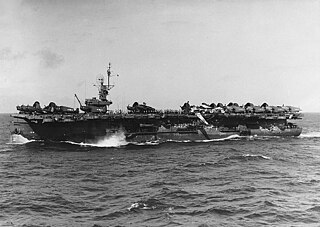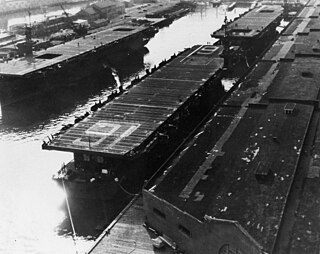
The Casablanca-class escort carrier were a series of escort carriers constructed for the United States Navy during World War II. They were the most numerous class of aircraft carriers ever built. Fifty were laid down, launched and commissioned within the space of less than two years – 3 November 1942 through to 8 July 1944. These were nearly one third of the 143 aircraft carriers built in the United States during the war. Despite their numbers, and the preservation of more famous and larger carriers as museums, none of these modest ships survive today. Five were lost to enemy action during World War II and the remainder were scrapped.

USS Admiralty Islands (CVE-99) was the forty-fifth of fifty Casablanca-class escort carrier built for the United States Navy during World War II. She was named after the Admiralty Islands campaign, a series of battles against isolated Japanese forces throughout the Admiralty Islands in the Bismarck Archipelago. The ship was launched in May 1944, commissioned in June, and served as a replenishment carrier, under the command of Capt. Edward Hastings Eldredge, in support of the invasion of Iwo Jima and the Battle of Okinawa. Postwar, she participated in Operation Magic Carpet. She was decommissioned in November 1946, when she was mothballed in the Pacific Reserve Fleet. Ultimately, she was sold for scrapping in January 1947.

USS Casablanca (AVG/ACV/CVE-55) was the first of fifty Casablanca-class escort carriers built for the United States Navy during World War II. She was named after the Naval Battle of Casablanca, conducted as a part of the wider Operation Torch, which pitted the United States Navy against the remnants of the French Navy controlled by Vichy France. The American victory cleared the way for the seizure of the port of Casablanca as well as the Allied occupation of French Morocco. The ship was launched in April 1943, commissioned in July, and served as a training and transport carrier throughout the war. Postwar, she participated in Operation Magic Carpet, repatriating U.S. servicemen from throughout the Pacific. She was decommissioned in June 1946, when she was mothballed in the Atlantic Reserve Fleet. She was sold for scrap in April 1947.

USS Munda (CVE-104) was the last of fifty United States Navy Casablanca-class escort carrier built for service during World War II. She was named after the Battle of Munda Point, which occurred on the island New Georgia, a part of the Solomon Islands in 1943. The ship was launched in May 1944, and commissioned in July, and served as an aircraft transport and as a replenishment escort carrier in the Pacific Theatre. Postwar, she participated in Operation Magic Carpet, the repatriation of U.S. forces from bases scattered around the Pacific. She was decommissioned in April 1946, when she was mothballed in the Pacific Reserve Fleet. Ultimately, she was sold for scrapping in June 1960.

USS Attu (CVE-102) was a Casablanca-class escort carrier of the United States Navy. She was named after the Battle of Attu in the Aleutian Islands and was built for service during World War II. Launched in May 1944, and commissioned in June, she served as a transport carrier, ferrying aircraft, and as a replenishment carrier, supporting the Invasion of Iwo Jima and the Battle of Okinawa. Postwar, she participated in Operation Magic Carpet. She was decommissioned in June 1946, and sold for scrapping in January 1947. After a failed acquisition attempt by the Jewish Agency, she was ultimately scrapped in 1949.
Three ships of the United States Navy have been named USS Coral Sea, commemorating the Battle of the Coral Sea during World War II. All three were aircraft carriers. Of the three vessels only one retained the name through its career.

USS Roi (CVE-103) was a Casablanca-class escort carrier of the United States Navy. She was named after the Battle of Roi, in which the United States captured the island of Roi-Namur. Built for service during World War II, the ship was launched in June 1944, commissioned in July, and acted as a transport and as a replenishment carrier. During the latter months of the war, she provided aircraft and supplies to the Fast Carrier Task Force, continuing until the end of the war. Postwar, she participated in Operation Magic Carpet. She was decommissioned in May 1946, and she was sold for scrapping in December.

USS Bougainville (CVE-100) was the forty-sixth of fifty Casablanca-class escort carrier built for the United States Navy during World War II. She was named after the Bougainville campaign, a prolonged action against Japanese forces entrenched in the island of Bougainville off Papua New Guinea. The ship was launched in May 1944, and commissioned in June, and served as a replenishment carrier in support of the invasion of Iwo Jima and the Battle of Okinawa. She was decommissioned in November 1946, when she was mothballed in the Pacific Reserve Fleet. Ultimately, she was sold for scrapping in August 1960.

USS Matanikau (CVE-101) was a Casablanca-class escort carrier of the United States Navy. She was named after the Actions along the Matanikau, a series of engagements during the Guadalcanal campaign. Built for service during World War II, the ship was launched in May 1944, and commissioned in June, and served as a training and transport carrier. Notably, some 1,332 aviators earned their qualifications on-board the carrier. Postwar, she participated in Operation Magic Carpet. She was decommissioned in October 1946, when she was mothballed in the Pacific Reserve Fleet. Ultimately, she was sold for scrapping in July 1960.

USS Hollandia (CVE-97) was a Casablanca-class escort carrier of the United States Navy. She was named after the Battle of Hollandia, a successful amphibious operation during the New Guinea campaign. Launched in April 1944, and commissioned in June, she served in support of the Battle of Okinawa. Postwar, she participated in Operation Magic Carpet. She was decommissioned in January 1947, when she was mothballed in the Pacific Reserve Fleet. Ultimately, she was sold for scrapping in December 1960.

USS Makassar Strait (CVE-91) was a Casablanca-class escort carrier of the United States Navy. She was named after the Battle of Makassar Strait, an early naval engagement to the east of Borneo. Launched in March 1944, and commissioned in April, she served in support of the Battle of Okinawa. Postwar, she participated in Operation Magic Carpet. She was decommissioned in August 1946, when she was mothballed in the Pacific Reserve Fleet. Ultimately, she was used as a target, and she was accidentally ran aground on San Nicolas Island in April 1961. Her wreckage survived until at least 1965.

USS Thetis Bay (CVE-90) was the thirty-sixth of fifty Casablanca-class escort carriers built for the United States Navy during World War II. She was launched in March 1944, commissioned in April, and served as a transport carrier in the Pacific, as well as a replenishment carrier supporting the Allied bombardment of Tokyo and the Main Islands. Postwar, she participated in Operation Magic Carpet, before being decommissioned in August 1946, being mothballed in the Pacific Reserve Fleet. She was reactivated in July 1956, and converted to a helicopter transport carrier, serving in relief operations in Taiwan and Haiti. Ultimately, she was broken up in 1966, the last Casablanca-class hull to be scrapped.

USS St. Lo (AVG/ACV/CVE–63) was a Casablanca-class escort carrier of the United States Navy during World War II. On 25 October 1944, St. Lo became the first major warship to sink as the result of a kamikaze attack. The attack occurred during the Battle off Samar, part of the larger Battle of Leyte Gulf.

USS Sitkoh Bay (CVE-86) was the thirty-second of fifty Casablanca-class escort carriers built for the United States Navy during World War II. She was named after Sitkoh Bay, located within Chichagof Island, of the Territory of Alaska. The ship was launched in February 1944, commissioned in March, and served as a replenishment and transport carrier throughout the Philippines campaign, the Invasion of Iwo Jima and the Battle of Okinawa. She was decommissioned in November 1946, when she was mothballed in the Atlantic Reserve Fleet. With the outbreak of the Korean War, however, she was called back to service, continuing to serve as a transport and utility carrier with the Military Sealift Command until 1954, when she was once again decommissioned, and mothballed in the Pacific Reserve Fleet. Ultimately, she was broken up in January 1961.
USS Vermillion could be referring to a number of different ships in the United States Navy. All of these vessels are named for a bay located in the Gulf of Mexico off the coast of Louisiana, southeast of Vermilion Parish and southwest of Iberia Parish.
Two ships have been named HMS Ameer:
Two ships of the United States Navy have been named Alikula Bay for one of bays on Coronation Island in Alaska.
Two ships of the United States Navy have been named Bucareli Bay for the bay off the western coast of Prince of Wales Island in Alaska.
Two ships of the United States Navy have been named Alazon Bay for Alazon Bay in Texas.
USS Didrickson Bay refers to one of two ships of the United States Navy named for Didrickson Bay in Alaska:












